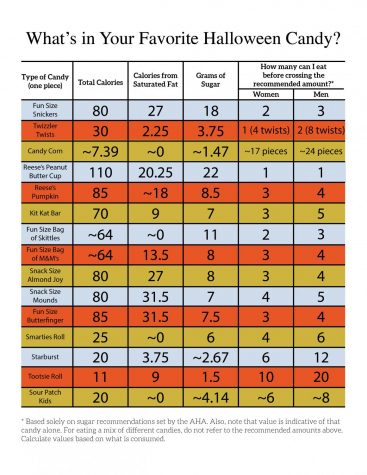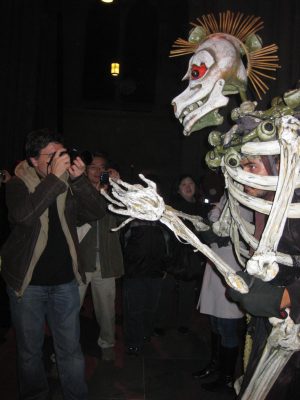Is Halloween Candy a Trick or a Treat?
Filled with sugars and fats, Halloween candy may not be the healthiest choice, but you can still enjoy it mindfully.
October 31, 2020
Halloween is the perfect time to dress up, socialize with friends and eat candy. You probably know that eating lots of candy might hold scary consequences for your health, but do you know why? Let’s break down the healthiness of candy. Warning: It might get a little spooky.
Fats: The Good, the Bad and the Ugly
Most candy is composed of fat, and fats can rapidly increase your caloric intake. They carry twice the amount of calories as carbs and proteins with nine calories per gram. There are three different types of fats: unsaturated, saturated and trans fats.
While unsaturated fats contain numerous health benefits, the latter two cause the most trouble. Candy is mainly composed of saturated fats.
MedlinePlus says that eating high amounts of saturated fats can lead to high cholesterol, which can put an individual at increased risk for coronary heart disease (CHD) or cardiovascular disease (CVD). But the T.H. Chan School of Public Health at Harvard University, among others, shows that there is not enough evidence to suggest any negative relationship between saturated fats and an increased risk in CHD or CVD.
Even though the exact science is still disputed, experts uniformly agree that replacing any saturated fats with unsaturated fats would be good for your health. Anything with trans fat is something that should be avoided because it is the worst type of fat, raising your cholesterol levels and creating inflammation, among other problems.
So what does that mean for you and eating candy? If it has trans fat, like the popular Snickers, Reese’s Pieces or Skittles, try to avoid it. If it has saturated fats, there is not necessarily a need to be alarmed; just try to keep the number of candies low.
The American Heart Association (AHA) recommends that no more than 5 to 6% of our daily calories come from saturated fats. Similarly, the U.S. Department of Agriculture recommends no more than 10%. While the number of calories consumed per day varies from person to person and depends on your weight, the Department of Health and Human Services recommends 1,800 to 2,400 calories per day for college-aged women and 2,400 to 3,000 calories per day for college-aged men. Using an abstract 2,000 calories as a base, that would mean, per the AHA, that no more than 100 to 120 calories should come from saturated fats.

Sugar: The Sweet and Sour Truth
There are two types of sugars. Natural sugars, as the name suggests, occur naturally in fruits and milk in the form of galactose and lactose and are okay to eat in any amount.
Added sugars, on the other hand, are not natural and correlate with obesity, diabetes and heart conditions. These sugars give candy its sweet taste. In addition, sugar can have negative effects on your teeth. When you consume sugar, a harmful bacteria produces an acid in your mouth that chips away at minerals that make up your enamel, the protective coating on your teeth. While you naturally regenerate these minerals, eating too much sugar in one sitting or over a period of time can overload the regeneration and cause cavities.
Regardless of your daily caloric intake, the AHA recommends that men consume under 36 grams (roughly equal to 150 calories or 9 teaspoons) of added sugar, and that women consume under 25 grams (about 100 calories or 6 teaspoons).
Counting Calories?
Sticking with the recommended amount of sugar and fat intake may limit your candy consumption this Halloween. If you count your calories, be mindful of how fast candy can take up your allotted daily caloric intake.
How Much Candy Can I Eat Every Day?
If you want to be health-conscious this Halloween, try to look at the amount of saturated fat and sugar on the nutrition label of the candy you eat. It’s best to stay within both recommendations, but you will hit your daily sugar intake faster than you will your saturated fat intake.
These candies are not healthy, but given that Halloween only comes around once a year, splurging for a week or two may not be much cause for concern.
If you do want to count your calories, the amount of candy you eat might look different. The most important thing when considering your health is to make sure you have a balanced diet. Sugar and fat intake is only one portion. While replacing your regular diet with candy could take you down a dangerous road, maintaining your diet and supplementing it with candy won’t break you.
As long as you brush your teeth and maintain a balanced diet, you can still have fun this Halloween.

















